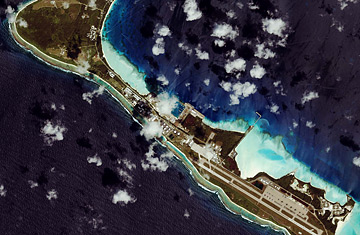
An aerial view of Diego Garcia, an atoll located in the heart of the Indian Ocean.
Here's a mental exercise for you: picture a tropical paradise lost in an endless expanse of cerulean ocean. Glossy palm fronds twist gently in the temperate wind, as islanders harvest coconuts along the immaculate powder-white beaches. Leathery sea turtles bob lazily off shore and the light cacophony of birdsong accents the ambient sound of wind and waves.
Now add concrete. Lots and lots of concrete. And B-2 bombers. Toss in a few high-value terrorists, deplaning from an unmarked CIA jet, hooded, shackled and headed for days and nights of the closest thing to torture that American interrogators can come up with while still claiming not to have violated the Geneva Conventions.
Welcome to Diego Garcia — 6,720 acres of restricted military base on a low-lying, depopulated atoll 1,000 miles from the nearest continent. Back in 1966, the U.S. signed a secret agreement with Great Britain allowing the Pentagon to use the Indian Ocean territory as an airbase in exchange for a big discount on Polaris nuclear missiles. Three years later, hundreds of Navy seabees arrived by ship and began pouring out the 12,000-foot runway that would become a bulwark of American Cold War strategy in the region, and a key launching pad for the first and second Gulf wars, the 1998 bombing of Iraq and the invasion of Afghanistan.
When I touched down aboard Air Force One with President Bush Tuesday for a 90-minute refueling stop en route from Iraq to Australia, Diego Garcia's esthetic impact was underwhelming: Think early-'70s industrial park for the architecture, and public elementary school for the interior design. But as a 1,700-man springboard for the projection of military might to the far reaches of the world, it rivals anything 18th century Britain or Augustinian Rome ever came up with.
Unfortunately, the Americans who built the base crossed the line from efficiency to cruelty. First, they killed the islanders' dogs. That is, they loaded the pets into sealed sheds, gassed them, and cremated them, according Prof. David Vine, a public anthropologist at American University in Washington who has studied the island's colonization by the U.S. Then the British loaded the inhabitants, known as Chagossians, onto ships and sent them off to Mauritius and the Seychelles, 1,200 miles to the west across the Indian Ocean, where they live to this day. A court case is under way in Britain seeking damages, and the government there has reportedly paid almost $30 million in compensation to the islanders. Last year, the Chagossians were allowed to visit the graves of their relatives for the first time.
Its troubled history and sensitive security role has helped make Diego Garcia pretty much off-limits for journalists. That, in turn, has made it something of a holy-grail dateline for reporters covering the military. Not that I saw much of it. After President Bush deplaned, he was greeted by an honor guard on the tarmac. We were taken 100 yards to a low, beige outbuilding and shown to an auditorium, while Bush met the base commander and some unspecified others. When I tried to leave the building to look around, I was told by some courteous airmen that I didn't have the proper clearance.
But if I wasn't going to get any reporting done on the expulsion of the Chagossians or the treatment of terror suspects such the Indonesian al-Qaeda leader Hambali, who is believed to have been held on the island, I at least wanted proof I'd been there. Twenty years ago, Time's Chief of Correspondents, Dick Duncan, offered a case of fine Bordeaux to the first correspondent who filed a legitimate story from Diego Garcia. The equivalent in 2007 media dollars is probably a box of Chablis, but in any case I wanted evidence.
One of the airmen guarding the exit spotted a civilian contractor, William L. Corke, who offered to grab some T-shirts. Half an hour later, Corke returned with a bag of shirts with colorful pictures of scantily clad women and mermaids bearing the words, "Fantasy Island, Diego Garcia."
Before we were hustled back onto Air Force One I managed to file a story for Time.com on Bush's surprise visit to Iraq. I'd rather have had something on detainee treatment or on the last remnants of Chagossian villages; maybe next time. However, the dateline for the story I did file was quickly transformed in blogosphere reprints into a joint byline that read, "by Massimo Calabresi and Diego Garcia."
